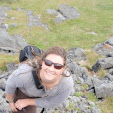
The trapping component of my study came to an abrupt end last Thursday as there was a serious problem with the contract of the rental truck. After a series of miscommunications, e-mails lost to cyber space, ect. we discovered that the contract for the field vehicle had expired after thirty days. I would have to open a new one to retain it any longer. And seeing as how the price was actually rather ungodly for a single day, I decided to save some money and call an end to the field study in Rinconada until I return in September to start collecting ecological data.
So after 2 months of intensive trapping, the tally comes to 30 individuals from 7 colonies. Tissue and fecal samples were collected from nearly all coruros. Leukocyte smears were made for nearly a third of these critters. These samples will tell us something about the stress levels of our fuzzy friends. The acoustic recordings are yet to be determined as I am still hesitant to say what will be able to use for analysis. It was a good run. To say the least.
As I have had some extra time on my hands, I have slowed down and done some city wandering. The city tells a fascinating story of history, progress and contradictions. The demographics are as intriguing as the beautiful faces I see on the streets. Perhaps you have to delve into the history books of Chile to really understand what is behind the simple gestures people have here on the streets. The young people display their affection so readily for others to see while the older generation content themselves with holding hands. Overall, Chile is far more affectionate than the United States. People kiss 'hello' and 'goodbye', and children and adults alike hold hands and interlock arms with their parents and grandparents while walking the streets. Sundays are quiet, for the exception of the barking stray dogs and honking horns after a fútbol game...
My new apartment has a view, but it's nothing really to speak of, simply apartment buildings and old cathedrals rising above the 2 story shopping areas. And as always the impressive looming Andes.
Today and tomorrow I prepare for my trip to Peru. This will include packing and repacking my travel bags, calling the embassy, a cab, completing my raw data entries and saving the document in a bazillion places, and writing down key Spanish phrases in my notebook that I forget so easily.
After three months in this country, I am functional in Spanish, but cetainly not fluent. That will take much more time. And some tutoring, which I will be signing up for upon my return.








